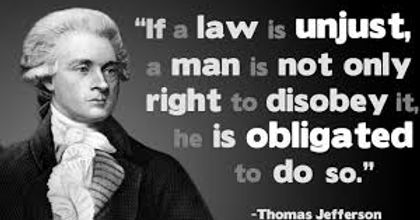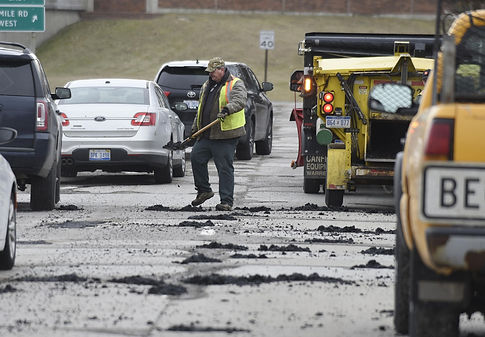Eddie KABACINSKI Committee to RETAIN for
the City of Warren DISTRICT 5 COUNCILMAN
-
The Supreme Court had ruled that the Privileges and Immunities Clause in Article 4 of the United States Constitution protected " The right to enter any other State whenever they ( sovereign American citizens ) pleased, singly or in companies, without pass or passport, and without obstruction, to sojourn there as long as they pleased, to go where they pleased at any hour of the day or night without molestation. "
-
“ Personal liberty largely consists of the Right of locomotion to go where and when one pleases only so far restrained as the Rights of others may make it necessary for the welfare of all other citizens. The Right of the Citizen to travel upon the public highways and to transport his property thereon, by horse drawn carriage, wagon, or automobile, is not a mere privilege which may be permitted or prohibited at will, but the common Right which he has under his Right to life, liberty, and the pursuit of happiness. Under this Constitutional guarantee one may, therefore, under normal conditions, travel at his inclination along the public
highways or in public places, and while conducting himself in an orderly and decent manner, neither interfering with nor disturbing another’s Rights, he will be protected, not only in his person, but in his safe conduct. ” - American Jurisprudence 1st. Constitutional Law, Section 329, p 1135.
-
For much of American history, the right to travel included the right to travel by the vehicle of one's choice as sovereign American citizens, and courts occasionally struck down regional regulations that required licenses or government permission to travel on public roadways.
-
With the advent of the automobile, however, courts began upholding laws and regulations requiring licenses to operate vehicles by sovereign American citizens on roadways should be opposed.

-
Licenses were unnecessary because every sovereign American citizen driver had a duty, presumably under common tort and contract law, to be competent in the use and knowledge of motor vehicles.
-
Many state courts declared driving an automobile a protected right, but nonetheless, found driver licenses passed constitutional muster. No court after 1920 found the right to travel sufficient to strike down a driver license requirement. Barely a decade into the twentieth century, the sovereign American citizen automobile drivers had largely given up the battle for the right to drive without a license.
-
Mandating that all law abiding, sovereign, American citizen drivers enter into a contract with a private insurance company to purchase a good or service like mandatory primary liability and primary disability insurance, or be punished by a fine labeled a " civil infraction or a criminal offense " is unprecedented in American history and should be opposed.
-
Since 1950, no court has described driving an automobile as a " right ". The constitutional right to travel became increasingly interpreted by the courts not as a right to locomotion by the means of one's choice, but as a mere right to emigrate between states. This narrow interpretation of the right to travel came about more from judicial neglect than from any clear doctrinal justification. Today, traffic bureaus refer to driving a motor vehicle only as a privilege and should be opposed.


-
The Interstate Highway System gained a champion in General Dwight David Eisenhower, who was influenced by his experiences as a United States Army officer crossing the country in the 1919 Army Convoy on the Lincoln Highway, the first road across America. Eisenhower gained an appreciation of the Reichsautobahn system, the first " national " implementation of modern Germany's Autobahn network, as a necessary component of a national defense system while he was serving as Supreme Commander of the Allied forces in Europe during World War 2. He recognized that the proposed system would also provide key ground transport routes for military supplies and troop deployments in case of an emergency or foreign invasion.
-
The United States Bureau of Public Roads asked the United States Army to provide a list of roads that it considered necessary for national defense.
-
The United States Army Corps of Engineers has supervised most of the construction for the United States Army and, after 1947, for the United States Air Force ( the navy has its own construction agencies ). It has also had important, if sometimes controversial, civil works responsibilities with the tasks of facilitating military movement by the construction of roads, bridges, and bases, and of protecting troops or territory through fortification, military engineering has been part of warfare since ancient times.
-
During the Cold War, the Corps of Engineers engaged in a major construction program as part of the military buildup of the early 1950's. In the United States and around the world, Army Corps of Engineers built airfields, roads, bridges, ports, petroleum pipelines, military camps and cantonments, warehouses, hospitals, and dozens of other facilities, including the Pentagon, the world's largest office building, completed in 1942.
-
The Dwight David Eisenhower National System of Interstate and Defense Highways ( commonly known as the Interstate Highway System, Interstate Freeways, or simply the Interstate ) is a network of controlled access highways that forms a part of the National Highway System of the United States. The system is named for President Dwight David Eisenhower, who championed its formation. Construction was authorized by the Federal Aid Highway Act of 1956, and the original portion was completed 35 years later, although some urban routes were cancelled and never built.
-
The Interstate Highway System was authorized on 29 June 1956 by the Federal Aid Highway Act of 1956, popularly known as the National Interstate and Defense Highways Act of 1956.


